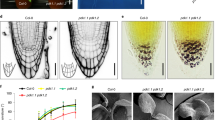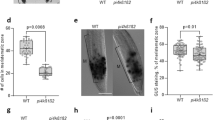Abstract
Development of diverse multicellular organisms relies on coordination of single-cell polarities within the plane of the tissue layer (planar polarity). Cell polarity often involves plasma membrane heterogeneity generated by accumulation of specific lipids and proteins into membrane subdomains. Coordinated hair positioning along Arabidopsis root epidermal cells provides a planar polarity model in plants, but knowledge about the functions of proteo-lipid domains in planar polarity signalling remains limited. Here we show that Rho-of-plant (ROP) 2 and 6, phosphatidylinositol-4-phosphate 5-kinase 3 (PIP5K3), DYNAMIN-RELATED PROTEIN (DRP) 1A and DRP2B accumulate in a sterol-enriched, polar membrane domain during root hair initiation. DRP1A, DRP2B, PIP5K3 and sterols are required for planar polarity and the AGCVIII kinase D6 PROTEIN KINASE (D6PK) is a modulator of this process. D6PK undergoes phosphatidylinositol-4,5-bisphosphate- and sterol-dependent basal-to-planar polarity switching into the polar, lipid-enriched domain just before hair formation, unravelling lipid-dependent D6PK localization during late planar polarity signalling.
This is a preview of subscription content, access via your institution
Access options
Subscribe to this journal
Receive 12 digital issues and online access to articles
$119.00 per year
only $9.92 per issue
Buy this article
- Purchase on Springer Link
- Instant access to full article PDF
Prices may be subject to local taxes which are calculated during checkout





Similar content being viewed by others
References
Lingwood, D. & Simons, K. Lipid rafts as a membrane-organizing principle. Science 327, 46–50 (2010).
Zappel, N. F. & Panstruga, R. Heterogeneity and lateral compartmentalization of plant plasma membranes. Curr. Opin. Plant Biol. 11, 632–640 (2008).
Nakamura, M., Kiefer, C. S. & Grebe, M. Planar polarity, tissue polarity and planar morphogenesis in plants. Curr. Opin. Plant Biol. 15, 593–600 (2012).
Molendijk, A. J. et al. Arabidopsis thaliana Rop GTPases are localized to tips of root hairs and control polar growth. EMBO J. 20, 2779–2788 (2001).
Jones, M. A. et al. The Arabidopsis Rop2 GTPase is a positive regulator of both root hair initiation and tip growth. Plant Cell 14, 763–776 (2002).
Kost, B. et al. Rac homologues and compartmentalized phosphatidylinositol 4, 5-bisphosphate act in a common pathway to regulate polar pollen tube growth. J. Cell Biol. 19, 317–330 (1999).
Willemsen, V. et al. Cell polarity and PIN protein positioning in Arabidopsis require STEROL METHYLTRANSFERASE1 function. Plant Cell 15, 612–625 (2003).
Men, S. et al. Sterol-dependent endocytosis mediates post-cytokinetic acquisition of PIN2 auxin efflux carrier polarity. Nature Cell Biol. 10, 237–244 (2008).
Meijer, H. J. & Munnik, T. Phospholipid-based signaling in plants. Ann. Rev. Plant Biol. 54, 265–306 (2003).
Synek, L., Sekeres, J. & Zarsky, V. The exocyst at the interface between cytoskeleton and membranes in eukaryotic cells. Front. Plant Sci. 4, 543 (2014).
Yoo, C. M., Quan, L., Cannon, A. E., Wen, J. & Blancaflor, E. B. AGD1, a class 1 ARF-GAP, acts in common signaling pathways with phosphoinositide metabolism and the actin cytoskeleton in controlling Arabidopsis root hair polarity. Plant J. 69, 1064–1076 (2012).
Braun, M., Baluska, F., von Witsch, M. & Menzel, D. Redistribution of actin, profilin and phosphatidylinositol-4, 5-bisphosphate in growing and maturing root hairs. Planta 209, 435–443 (1999).
Kusano, H. et al. The Arabidopsis Phosphatidylinositol Phosphate 5-Kinase PIP5K3 is a key regulator of root hair tip growth. Plant Cell 20, 367–380 (2008).
Stenzel, I. et al. The type B phosphatidylinositol-4-phosphate 5-kinase 3 is essential for root hair formation in Arabidopsis thaliana. Plant Cell 20, 124–141 (2008).
Preuss, M. L. et al. A role for the RabA4b effector protein PI-4Kbeta1 in polarized expansion of root hair cells in Arabidopsis thaliana. J. Cell Biol. 172, 991–998 (2006).
Thole, J. M., Vermeer, J. E., Zhang, Y., Gadella, T. W. Jr. & Nielsen, E. Root hair defective4 encodes a phosphatidylinositol-4-phosphate phosphatase required for proper root hair development in Arabidopsis thaliana. Plant Cell 20, 381–395 (2008).
Ischebeck, T. et al. Phosphatidylinositol 4,5-bisphosphate influences PIN polarization by controlling clathrin-mediated membrane trafficking in Arabidopsis. Plant Cell 25, 4894–4911 (2013).
Tejos, R. et al. Bipolar plasma membrane distribution of phosphoinositides and their requirement for auxin-mediated cell polarity and patterning in Arabidopsis. Plant Cell 26, 2114–2128 (2014).
Barbosa, I. C., Zourelidou, M., Willige, B. C., Weller, B. & Schwechheimer, C. D6 PROTEIN KINASE activates auxin transport-dependent growth and PIN-FORMED phosphorylation at the plasma membrane. Dev. Cell 29, 674–685 (2014).
Zourelidou, M. et al. Auxin efflux by PIN-FORMED proteins is activated by two different protein kinases, D6 PROTEIN KINASE and PINOID. eLife e02860 (2014).
Zourelidou, M. et al. The polarly localized D6 PROTEIN KINASE is required for efficient auxin transport in Arabidopsis thaliana. Development 136, 627–636 (2009).
Willige, B. C. et al. D6PK AGCVIII kinases are required for auxin transport and phototropic hypocotyl bending in Arabidopsis. Plant Cell 25, 1674–1688 (2013).
Pearce, L. R., David Komander, D. & Alessi, D. R. The nuts and bolts of AGC protein kinases. Nature Rev. Mol. Cell Biol. 11, 9–22 (2010).
Dhonukshe, P. et al. Clathrin-mediated constitutive endocytosis of PIN auxin efflux carriers in Arabidopsis. Curr. Biol. 17, 520–527 (2007).
Kitakura, S. et al. Clathrin mediates endocytosis and polar distribution of PIN auxin transporters in Arabidopsis. Plant Cell 23, 1920–1931 (2011).
Kang, B. H., Busse, J. S. & Bednarek, S. Y. Members of the Arabidopsis dynamin-like gene family, ADL1, are essential for plant cytokinesis and polarized cell growth. Plant Cell 15, 899–913 (2003).
Collings, D. A. et al. Arabidopsis dynamin-like protein DRP1A: a null mutant with widespread defects in endocytosis, cellulose synthesis, cytokinesis, and cell expansion. J. Exp. Bot. 59, 361–376 (2008).
Backues, S. K., Korasick, D. A., Heese, A. & Bednarek, S. The Arabidopsis dynamin-related protein2 family is essential for gametophyte development. Plant Cell 22, 3218–3231 (2010).
Fujimoto, M. et al. Arabidopsis dynamin-related proteins DRP2B and DRP1A participate together in clathrin-coated vesicle formation during endocytosis. Proc. Natl Acad. Sci. USA 107, 6094–6099 (2010).
Konopka, C. A. & Bednarek, S. Y. Comparison of the dynamics and functional redundancy of the Arabidopsis dynamin-related isoforms DRP1A and DRP1C during plant development. Plant Physiol. 147, 1590–1602 (2008).
Konopka, C. A., Backues, S. K. & Bednarek, S. Y. Dynamics of Arabidopsis dynamin-related protein 1C and a clathrin light chain at the plasma membrane. Plant Cell 20, 1363–1380 (2008).
Wang, C. et al. Clathrin light chains regulate clathrin-mediated trafficking, auxin signaling, and development in Arabidopsis. Plant Cell 25, 499–516 (2013).
Grebe, M. et al. Arabidopsis sterol endocytosis involves actin-mediated trafficking via ARA6-positive early endosomes. Curr. Biol. 13, 1378–1387 (2003).
Boutté, Y., Men, S. & Grebe, M. Fluorescent in situ visualization of sterols in Arabidopsis roots. Nature Protoc. 6, 446–456 (2011).
Ovečka, M. et al. Structural sterols are involved in both the initiation and tip growth of root hairs in Arabidopsis thaliana. Plant Cell 22, 2999–3019 (2010).
Xu, J. & Scheres, B. Dissection of Arabidopsis ADP-RIBOSYLATION FACTOR 1 function in epidermal cell polarity. Plant Cell 17, 525–536 (2005).
Fu, Y., Xu, T., Zhu, L., Wen, M. & Yang, Z. A ROP GTPase signaling pathway controls cortical microtubule ordering and cell expansion in Arabidopsis. Curr. Biol. 19, 1827–1832 (2009).
Sorek, N. et al. Activation status-coupled transient S acylation determines membrane partitioning of a plant Rho-related GTPase. Mol. Cell. Biol. 27, 2144–2154 (2007).
Mongrand, S. et al. Lipid rafts in higher plant cells: purification and characterization of Triton X-100-insoluble microdomains from tobacco plasma membrane. J. Biol. Chem. 279, 36277–36286 (2004).
Borner, G. H. et al. Analysis of detergent-resistant membranes in Arabidopsis. Evidence for plasma membrane lipid rafts. Plant Physiol. 137, 104–116 (2005).
Minami, A. et al. Alterations in detergent-resistant plasma membrane microdomains in Arabidopsis thaliana during cold acclimation. Plant Cell Physiol. 50, 341–359 (2009).
Frescatada-Rosa, M. et al. High lipid order of Arabidopsis cell plate membranes mediated by sterol and DYNAMIN-RELATED PROTEIN1A function. Plant J. 80, 745–757 (2014).
Souter, M. et al. Hydra mutants of Arabidopsis are defective in sterol profiles and auxin and ethylene signaling. Plant Cell 14, 1017–1031 (2002).
Posé, D. et al. Identification of the Arabidopsis dry2/sqe1–5 mutant reveals a central role for sterols in drought tolerance and regulation of reactive oxygen species. Plant J. 59, 63–76 (2009).
Kiefer, C. S. et al. Arabidopsis AIP1–2 restricted by WER-mediated patterning modulates planar polarity. Development 142, 151–161 (2015).
Grebe, M. et al. Cell polarity signaling in Arabidopsis involves a BFA-sensitive auxin influx pathway. Curr. Biol. 12, 329–334 (2002).
Fischer, U. et al. Vectorial information for Arabidopsis planar polarity is mediated by combined AUX1, EIN2, and GNOM activity. Curr. Biol. 16, 2143–2149 (2006).
Ikeda, Y. et al. Local auxin biosynthesis modulates gradient-directed planar polarity in Arabidopsis. Nature Cell Biol. 11, 731–738 (2009).
Furt, F. et al. Polyphosphoinositides are enriched in plant membrane rafts and form microdomains in the plasma membrane. Plant Physiol. 152, 2173–2187 (2010).
Raffaele, S. et al. Remorin, solanaceae protein resident in membrane rafts and plasmodesmata, impairs potato virus X movement. Plant Cell 21, 1541–1555 (2009).
Keinath, N. F. et al. PAMP (pathogen-associated molecular pattern)-induced changes in plasma membrane compartmentalization reveal novel components of plant immunity. J. Biol. Chem. 285, 39140–39149 (2010).
Markham, J. E. et al. Sphingolipids containing very-long-chain fatty acids define a secretory pathway for specific polar plasma membrane protein targeting in Arabidopsis. Plant Cell 23, 2362–2378 (2011).
Mravec, J. et al. Cell plate restricted association of DRP1A and PIN proteins is required for cell polarity establishment in Arabidopsis. Curr. Biol. 21, 1055–1060 (2011).
Titapiwatanakun, B. et al. ABCB19/PGP19 stabilises PIN1 in membrane microdomains in Arabidopsis. Plant J. 57, 27–44 (2009).
Pietra, S. et al. Arabidopsis SABRE and CLASP interact to stabilize cell division plane orientation and planar polarity. Nat. Commun. 4, 2779 (2013).
Acknowledgements
We are grateful to T. Aoyama, S.Y. Bednarek, D.W. Ehrhardt, N. Geldner, B. Scheres, N. Tsutsumi, R.E. Williamson and Z. Yang for sharing published materials. We thank the Nottingham Arabidopsis Stock Centre for providing seed stocks. A.H. and T.S. were supported by a grant from the Swedish Kempe foundations to M.G., A.H. and A.G. were supported by a ‘ShapeSystems’ project grant number 2012.0050 by the Knut & Alice Wallenberg foundation to M.G., T.S. and M.G. were supported by ERC-2010-STG Green-Lat-Pol, grant number 260699 to M.G.
Author information
Authors and Affiliations
Contributions
M.G. conceived the project. A.H., C.S., I.C.R.B., M.G., T.S. and S.P. designed experiments. A.G., A.H., C.S.K., I.C.R.B., K.B., M.G., M.Z., S.P. and T.S. performed experiments and interpreted the results. I.C.R.B., M.Z. and C.S. provided unpublished materials, discussions on experimental design and interpretation of results. M.G. and T.S. wrote the manuscript. All authors read the manuscript, edited and commented on it before submission.
Corresponding author
Ethics declarations
Competing interests
The authors declare no competing financial interests.
Supplementary information
Rights and permissions
About this article
Cite this article
Stanislas, T., Hüser, A., Barbosa, I. et al. Arabidopsis D6PK is a lipid domain-dependent mediator of root epidermal planar polarity. Nature Plants 1, 15162 (2015). https://doi.org/10.1038/nplants.2015.162
Received:
Accepted:
Published:
DOI: https://doi.org/10.1038/nplants.2015.162
This article is cited by
-
Two subtypes of GTPase-activating proteins coordinate tip growth and cell size regulation in Physcomitrium patens
Nature Communications (2023)
-
D6 protein kinase in root xylem benefiting resistance to Fusarium reveals infection and defense mechanisms in tung trees
Horticulture Research (2021)



